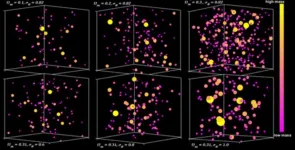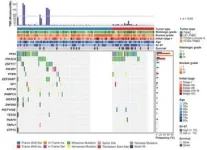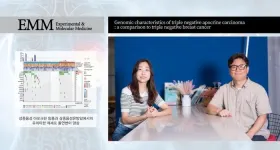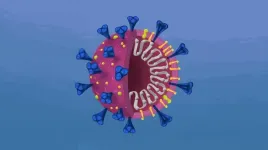Matter comprises of 31% of the total amount of matter and energy in the universe
A research team relies on measuring the number of galaxy members to determine the mass of galaxy clusters
2023-09-13
(Press-News.org)
“Cosmologists believe that only about 20% of the total matter is made of regular or ‘baryonic’ matter, which includes stars, galaxies, atoms, and life,” explains first author Dr. Mohamed Abdullah, a researcher at the National Research Institute of Astronomy and Geophysics-Egypt, Chiba University, Japan. “About 80% is made of dark matter, whose mysterious nature is not yet known but may consist of some as-yet-undiscovered subatomic particles.” (Fig. 1)
“The team used a well-proven technique to determine the total amount of matter in the universe, which is to compare the observed number and mass of galaxy clusters per unit volume with predictions from numerical simulations,” says co-author Gillian Wilson, Abdullah’s former graduate advisor and Professor of Physics and Vice Chancellor for research, innovation, and economic development at UC Merced. “The number of clusters observed at the present time, the so-called ‘cluster abundance,’ is very sensitive to cosmological conditions and, in particular, the total amount of matter.”
“A higher percentage of the total matter in the universe would result in more clusters being formed,” says Anatoly Klypin from University of Virginia. “But it is difficult to measure the mass of any galaxy cluster accurately as most of the matter is dark, and we cannot see it directly with telescopes.”
To overcome this difficulty, the team was forced to use an indirect tracer of cluster mass. They relied upon the fact that more massive clusters contain more galaxies than less massive clusters (mass richness relation: MRR). Because galaxies consist of luminous stars, the number of galaxies in each cluster can be utilized as a way of indirectly determining its total mass. By measuring the number of galaxies in each cluster in their sample from the Sloan Digital Sky Survey, the team was able to estimate the total mass of each of the clusters. They were then able to compare the observed number and mass of galaxy clusters per unit volume against predictions from numerical simulations. The best-fit match between observations and simulations was with a universe consisting of 31% of the total matter, a value that was in excellent agreement with that obtained using cosmic microwave background (CMB) observations from the Planck satellite. Notably, CMB is a completely independent technique.
“We have succeeded in making the first measurement of matter density using the MRR, which is in excellent agreement with that obtained by the Planck team using the CMB method,” says Tomoaki Ishiyama from Chiba University. “This work further demonstrates that cluster abundance is a competitive technique for constraining cosmological parameters and complementary to non-cluster techniques such as CMB anisotropies, baryon acoustic oscillations, Type Ia supernovae, or gravitational lensing.”
The team credits their achievement as being the first to successfully utilize spectroscopy, the technique that separates radiation into a spectrum of individual bands or colors, to precisely determine the distance to each cluster and the true member galaxies that are gravitationally bound to the cluster rather than background or foreground interlopers along the line of sight. Previous studies that attempted to use the MRR technique relied on much cruder and less accurate imaging techniques, such as using pictures of the sky taken at some wavelengths, to determine the distance to each cluster and the nearby galaxies that were true members.
The paper, published in The Astrophysical Journal, not only demonstrates that the MRR technique is a powerful tool for determining cosmological parameters but also explains how it can be applied to new datasets that are available from large, wide, and deep-field imaging, and spectroscopic galaxy surveys such as those performed with Subaru Telescope, Dark Energy Survey, Dark Energy Spectroscopic Instrument, Euclid Telescope, eROSITA Telescope, and the James Webb Space Telescope.
About Associate Professor Tomoaki Ishiyama
Tomoaki Ishiyama is an Associate Professor at the Digital Transformation Enhancement Council, Chiba University. His research focuses on elucidating the formation and evolution of various astronomical objects, such as galaxies and large-scale structures of the universe, as well as the study of dark matter structures within galaxies. His simulation movie showcasing the formation of dark matter structure has garnered over 300,000 views on YouTube.
END
[Attachments] See images for this press release:


ELSE PRESS RELEASES FROM THIS DATE:
2023-09-13
The University of Chicago will launch a pioneering new center aimed at shifting the popular narrative around the physical and cognitive impacts of aging.
Headed by leading neuroscientist Emily Rogalski, PhD, the new University of Chicago Healthy Aging & Alzheimer's Research Care (HAARC) Center will focus on building deep multidisciplinary expertise and bridging the gap between scientific disciplines to accelerate breakthroughs in cognitive resilience.
“We want to increase awareness and the scientific probability ...
2023-09-13
IIASA is proud to announce the launch of its Flagship Report, "Systems Analysis for Sustainable Wellbeing. 50 Years of IIASA Research, 40 Years After the Brundtland Commission, Contributing to the Post-2030 Global Agenda” on Wednesday, 13 September 2023 at an official UN event in the framework of the 78th session of the UN General Assembly and the Sustainable Development Goals mid-term review.
The IIASA Flagship Report chronicles the extraordinary 50-year journey of IIASA, a globally renowned institute providing systems analytical expertise on complex global challenges. Co-sponsored by the Permanent Missions of Austria and South Africa ...
2023-09-13
Washington, September 13, 2023—The United States has the largest age gap in voter turnout among advanced democracies. Youth voter turnout remained low, at 48 percent, in 2020. Scholars, educators, and policymakers often recommend civic education as a solution to low youth voter turnout.
However, new research finds that a commonly used state-mandated civics test policy—the Civics Education Initiative (CEI)—does not improve youth voter turnout, at least in the short term. The study, by Jilli Jung and Maithreyi Gopalan, both at Pennsylvania State University, was published today in Educational ...
2023-09-13
Breast cancer research takes a significant stride forward as Professor Semin Lee and his research team from the Department of Biomedical Engineering at UNIST, in collaboration with Professor Ji-Yeon Kim and Professor Young-Hyuck Im from the Division of Hematology-Oncology at Samsung Medical Center in Seoul, delves into the exploration of triple negative apocrine carcinoma. This rare breast cancer subtype has garnered attention due to its unique genetic characteristics and improved prognosis when compared to other forms of triple-negative breast cancer (TNBC).
Triple negative ...
2023-09-13
New research led by the Institute of Psychiatry, Psychology & Neuroscience (IoPPN) at King’s College London has found that depression and the risk of depression are linked to different inflammatory proteins in boys and girls.
When inflammation occurs in the body a host of proteins are released into the blood called cytokines. Previous research has shown that higher levels of cytokines are associated with depression in adults, but little is known about this relationship in adolescence.
Researchers investigated sex-differences in the relationship between inflammatory proteins and depression. Published in the Journal of ...
2023-09-13
Researchers from University of Colorado Denver, Iowa State University, and Arizona State University published a new Journal of Marketing study that examines the stock market effects on these contests and the contest characteristics that may enable such contests to pay off.
The study, forthcoming in the Journal of Marketing, is titled “When Do Marketing Ideation Crowdsourcing Contests Create Shareholder Value? The Effect of Contest Design and Marketing Resource Factors” and is authored by Zixia Cao, Hui Feng, and Michael A. Wiles.
Crowdsourcing contests for marketing ideas such as new ads, graphics, and products have become quite popular ...
2023-09-13
Sitting calmly in their webs, many spiders wait for prey to come to them. Arachnids along lakes and rivers eat aquatic insects, such as dragonflies. But, when these insects live in mercury-contaminated waterways, they can pass the metal along to the spiders that feed on them. Now, researchers reporting in ACS’ Environmental Science & Technology Letters have demonstrated how some shoreline spiders can move mercury contamination from riverbeds up the food chain to land animals.
Most mercury that enters waterways ...
2023-09-13
DALLAS, September 13, 2023 — On Tuesday, Sept. 12, the American Heart Association, a global force for healthier lives for all, recognized 19 students, schools and educators for their commitment to end cardiovascular disease, the nation’s no. 1 killer, through the Association’s in-school programs, Kids Heart Challenge™ and American Heart Challenge™. The annual National Awards Ceremony, held virtually, was joined by program participants from coast to coast and ...
2023-09-13
Washington, D.C. — Sept. 13, 2023 — The American Society for Microbiology today released consensus recommendations from a workshop of leading scientists who reviewed the benefits and risks of “gain of function” research, as well as related policies and procedures, and proposed a foundation to guide discussions and improve oversight moving forward.
The recommendations – together with a call to action for the scientific community and the general public – are intended to inform assessments of “gain of function research of concern,” which makes up a small fraction of all biological research. ...
2023-09-13
New UC Riverside research has revealed COVID’s Achilles heel — its dependence on key human proteins for its replication — which can be used to prevent the virus from making people sick.
In a new paper published in the journal Viruses, the UCR research team describes an important discovery. The protein in COVID that enables the virus to make copies of itself, called N, requires the help of human cells to perform its job.
Genetic instructions in our cells are transcribed from DNA to messenger ...
LAST 30 PRESS RELEASES:
[Press-News.org] Matter comprises of 31% of the total amount of matter and energy in the universe
A research team relies on measuring the number of galaxy members to determine the mass of galaxy clusters





